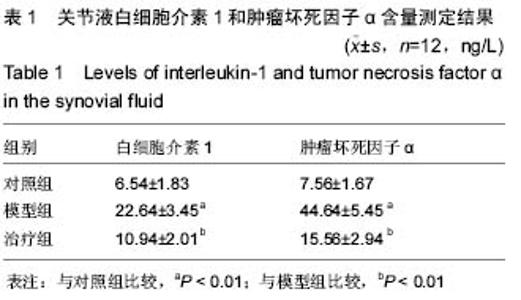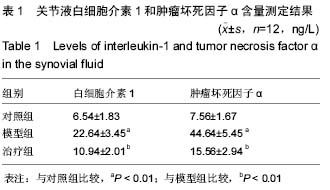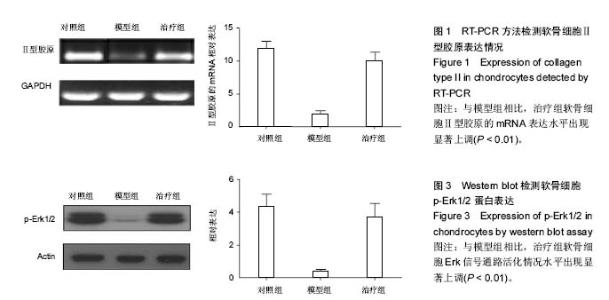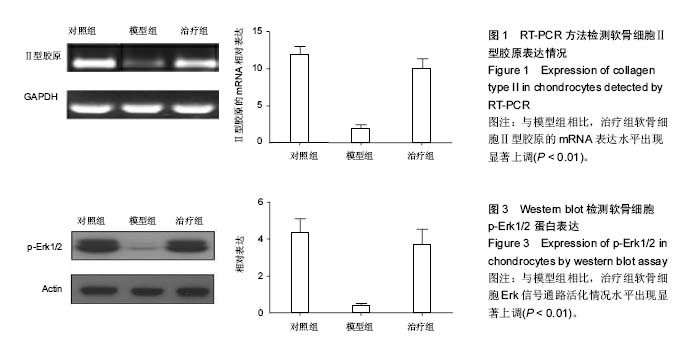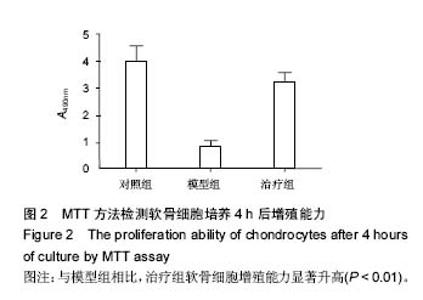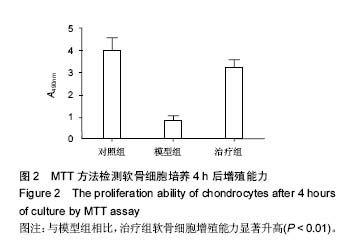Chinese Journal of Tissue Engineering Research
Previous Articles Next Articles
Erk activation and proliferation in osteoarthritc chondrocytes after continuous passive motion
Muyesaier•Maimaitiniyazi, Hu Yi, Ren Yun-ping, Zhang Yong, Xiong Dao-hai
- the Affiliated Fifth Hospital of Xinjiang Medical University, Urumqi 830011, Xinjiang Uygur Autonomous Region, China
-
Received:2016-07-24Online:2016-10-14Published:2016-10-14 -
Contact:Xiong Dao-hai, Master, Chief physician, the Affiliated Fifth Hospital of Xinjiang Medical University, Urumqi 830011, Xinjiang Uygur Autonomous Region, China -
About author:Muyesaier?Maimaitiniyazi, Studying for master’s degree, the Affiliated Fifth Hospital of Xinjiang Medical University, Urumqi 830011, Xinjiang Uygur Autonomous Region, China -
Supported by:the Natural Science Foundation of Xinjiang Uygur Autonomous Region, No. 2013211A060
CLC Number:
Cite this article
Muyesaier•Maimaitiniyazi, Hu Yi, Ren Yun-ping, Zhang Yong, Xiong Dao-hai. Erk activation and proliferation in osteoarthritc chondrocytes after continuous passive motion[J]. Chinese Journal of Tissue Engineering Research, doi: 10.3969/j.issn.2095-4344.2016.42.005.
share this article
| [1] García-Padilla S, Duarte-Vázquez MA, Gonzalez-Romero KE, et al. Effectiveness of intra-articular injections of sodium bicarbonate and calcium gluconate in the treatment of osteoarthritis of the knee: a randomized double-blind clinical trial. BMC Musculoskelet Disord.2015; 16(1):114. [2] Osajie FE, Yakubu K.A retrospective non-comparative analysis of the quality of care for osteoarthritis at the general out-patient department of Jos University Teaching Hospital, Nigeria.J Family Med Prim Care. 2015; 4(2):217-220. [3] Tsolis KC, Bei ES, Papathanasiou I, et al. Comparative proteomic analysis of hypertrophic chondrocytes in osteoarthritis. Clin Proteomics.2015; 12(1):12. [4] Liao EY,Luo XH.Effects of 17beta-estradiol on the expression of matrix metalloproteinase-1, -2 and tissue inhibitor of metalloproteinase-1 in human osteoblast-like cell cultures. Endocrine.2001; 15(3):291-295. [5] 张云,王艳,张京,等.持续被动运动对兔骨关节炎软骨细胞中G/J 活性及细胞凋亡的影响[J].中国临床研究,2016, 29(3):381-383. [6] Xie GP, Jiang N, Wang SN, et al. Eucommia ulmoides Oliv. bark aqueous extract inhibits osteoarthritis in a rat model of osteoarthritis. J Ethnopharmacol.2015; 162: 148-154. [7] Kitay GS, Koren MJ, Helfet DL,et al.Efficacy of combined local mechanical vibrations, continuous passive motion and thermotherapy in the management of osteoarthritis of the knee. Osteoarthritis Cartilage. 2009;17(10):1269-1274. [8] Liu L, Gu H, Liu H, et al.Protective effect of resveratrol against IL-1β-induced inflammatory response on human osteoarthritic chondrocytes partly via the TLR4/MyD88/NF-κB signaling pathway: an “in vitro study”. Int J Mol Sci. 2014; 15(4):6925-6940. [9] Kou S, Wu Y. Meta-analysis of tumor necrosis factor alpha -308 polymorphism and knee osteoarthritis risk[J]. BMC Musculoskelet Disord. 2014; 15:373. [10] Chen Q, Zhang B, Yi T, et al. Increased apoptosis in human knee osteoarthritis cartilage related to the expression of protein kinase B and protein kinase Ca in chondrocytes. Folia Histochem Cytobiol. 2012; 50(1): 137-143. [11] Huang JG, Xia C, Zheng XP, et al. 17β-Estradiol promotes cell proliferation in rat osteoarthritis model chondrocytes via PI3K/AKT pathway. Cell Mol Biol Lett. 2011; 16(4): 564-575. [12] 邓小兰,晋贞超,王健,等. ERK途径可能参与抗坏血酸诱导的神经干细胞向多巴胺能细胞分化[J]. 第三军医大学学报,2013,35(22):2430-2434. [13] Green DM, Noble PC, Bocell JR Jr, et al. Effect of early full weight-bearing after joint injury on inflammation and cartilage degradation. J Bone Joint Surg Am. 2006; 88:2201-2209. [14] Xu Y, Dai GJ, Liu Q, et al. Sanmiao formula inhibits chondrocyte apoptosis and cartilage matrix degradation in a rat model of osteoarthritis. Exp Ther Med. 2014; 8(4):1065-1074. [15] Thomas CM, Fuller CJ, Whittles CE, et al. Chondrocyte death by apoptosis is associated with the initiation and severity of articular cartilage degradation. Int J Rheum Dis. 2011;14(2): 191-198. [16] Mahmoud RK, EI-Ansary AK, El-Eishi HH, et al. Matrix metalloproteinases MMP-3 and MMP-1 levels in sera and synovial fluids in patients with rheumatoid arthritis and osteoarthritis.Biochem.2005; 54:248-257. [17] 单鹏程,何名江,张洪美,等. 温阳益髓中药干预兔膝骨关节炎软骨基质金属蛋白酶的表达[J]. 中国组织工程研究, 2014,18(7):997-1002. [18] Johnson AR, Pavlovsky AG, Ortwine DF, et al. Discovery and characterization of a novel inhibitor of matrix metalloprotease-13 that reduces cartilage damage in vivo without joint fibroplasia side effects. J Biol Chem. 2007; 282: 27781-91. [19] Stanton H, Rogerson FM, East CJ, et al. ADAMTS5 is the major aggrecanase in mouse cartilage in vivo and in vitro. Nature. 2005; 434: 648-652. [20] Shiozawa S, Tsumiyama K. Pathogenesis of rheumatoid arthritis and c-Fos/AP-1. Cell Cycle. 2009; 8(10):1539-1543. [21] 郭秦炜,田得祥,敖英芳.骨性关节炎关节软骨中I型、II型、III型及X型胶原的分布[J].中国运动医学杂志,2002,21(3): 228-231. [22] Willian Hunter.Of the structure and disease of the articular cartilage .Clin Orthop.2006; 11(3):317. [23] Mort JS Billington CJ. Articular cartilage and changes in arthritis matrix degradation. Arthritis Res.2001; 3: 337-341. [24] Little CB, Barai A, Burkhardt D, et al. Matrix metalloproteinase 13-deficient mice are resistant to osteoarthritic cartilage erosion but not chondrocyte hypertrophy or osteophyte development. Arthritis Rheum.2009; 60:3723-3733. [25] Wang L,Gai P,Xu R,et al. Shikonin protects chondrocytes from interleukin-1beta-induced apoptosis by regulating PI3K/Akt signalingpathway.Int J Clin Exp Pathol. 2015; 8(1):298-308. [26] Takahashi M, Naito K, Abe M, et al. Relationship between radiographic grading of osteoarthritis and the biochemical markers for arthritis in knee osteoarthritis. Arthritis Res Ther. 2004; 6:R208-R212. [27] Scarpellini M, Lurati A, Vignati G, et al. Biomarkers, type II collagen, glucosamine and chondroitin sulfate in osteoarthritis follow-up: the Magenta osteoarthritis study. J Orthop Traumatol. 2008; 9(2):81-87. [28] Tong KM, Shieh DC, Chen CP, et al.Leptin induces IL-8 expression via leptin receptor, IRS-1, PI3K, Akt cascade and promotion of NFkappaB /p300 binding in human synovial fibroblasts. Cell Signal. 2008;20(8): 1478-1488. [29] Liacini A, Sylvester J, Zafarullah M, et al.Mithramycin downregulates proinflammatory cytokine-induced matrixmetallop roteinase gene expression in articular chondrocytes.Arthritis Res Ther.2005; 7:777-783. [30] Jain A, Nanchahal J, Troeberg L, et al. Production of cytokines,vascular endothelial growth factor, matrix metalloproteinases, and tissue inhibitors of metalloproteinases 1 by tenosynovium demonstrates its potential for tendon destruction in rheumatoid arthritis. Arthritis Rheum.2001; 44: 1754-1760. |
| [1] | Zhang Tongtong, Wang Zhonghua, Wen Jie, Song Yuxin, Liu Lin. Application of three-dimensional printing model in surgical resection and reconstruction of cervical tumor [J]. Chinese Journal of Tissue Engineering Research, 2021, 25(9): 1335-1339. |
| [2] | Peng Zhihao, Feng Zongquan, Zou Yonggen, Niu Guoqing, Wu Feng. Relationship of lower limb force line and the progression of lateral compartment arthritis after unicompartmental knee arthroplasty with mobile bearing [J]. Chinese Journal of Tissue Engineering Research, 2021, 25(9): 1368-1374. |
| [3] | Huang Dengcheng, Wang Zhike, Cao Xuewei. Comparison of the short-term efficacy of extracorporeal shock wave therapy for middle-aged and elderly knee osteoarthritis: a meta-analysis [J]. Chinese Journal of Tissue Engineering Research, 2021, 25(9): 1471-1476. |
| [4] | Liu Xiangxiang, Huang Yunmei, Chen Wenlie, Lin Ruhui, Lu Xiaodong, Li Zuanfang, Xu Yaye, Huang Meiya, Li Xihai. Ultrastructural changes of the white zone cells of the meniscus in a rat model of early osteoarthritis [J]. Chinese Journal of Tissue Engineering Research, 2021, 25(8): 1237-1242. |
| [5] | Zeng Yanhua, Hao Yanlei. In vitro culture and purification of Schwann cells: a systematic review [J]. Chinese Journal of Tissue Engineering Research, 2021, 25(7): 1135-1141. |
| [6] | Xie Chongxin, Zhang Lei. Comparison of knee degeneration after anterior cruciate ligament reconstruction with or without remnant preservation [J]. Chinese Journal of Tissue Engineering Research, 2021, 25(5): 735-740. |
| [7] | Cao Xuhan, Bai Zixing, Sun Chengyi, Yang Yanjun, Sun Weidong. Mechanism of “Ruxiang-Moyao” herbal pair in the treatment of knee osteoarthritis based on network pharmacology [J]. Chinese Journal of Tissue Engineering Research, 2021, 25(5): 746-753. |
| [8] | Li Yonghua, Feng Qiang, Tan Renting, Huang Shifu, Qiu Jinlong, Yin Heng. Molecular mechanism of Eucommia ulmoides active ingredients treating synovitis of knee osteoarthritis: an analysis based on network pharmacology [J]. Chinese Journal of Tissue Engineering Research, 2021, 25(5): 765-771. |
| [9] | Song Shan, Hu Fangyuan, Qiao Jun, Wang Jia, Zhang Shengxiao, Li Xiaofeng. An insight into biomarkers of osteoarthritis synovium based on bioinformatics [J]. Chinese Journal of Tissue Engineering Research, 2021, 25(5): 785-790. |
| [10] | Deng Zhenhan, Huang Yong, Xiao Lulu, Chen Yulin, Zhu Weimin, Lu Wei, Wang Daping. Role and application of bone morphogenetic proteins in articular cartilage regeneration [J]. Chinese Journal of Tissue Engineering Research, 2021, 25(5): 798-806. |
| [11] | Xu Dongzi, Zhang Ting, Ouyang Zhaolian. The global competitive situation of cardiac tissue engineering based on patent analysis [J]. Chinese Journal of Tissue Engineering Research, 2021, 25(5): 807-812. |
| [12] | Liu Xin, Yan Feihua, Hong Kunhao. Delaying cartilage degeneration by regulating the expression of aquaporins in rats with knee osteoarthritis [J]. Chinese Journal of Tissue Engineering Research, 2021, 25(5): 668-673. |
| [13] | Ma Zetao, Zeng Hui, Wang Deli, Weng Jian, Feng Song. MicroRNA-138-5p regulates chondrocyte proliferation and autophagy [J]. Chinese Journal of Tissue Engineering Research, 2021, 25(5): 674-678. |
| [14] | Wu Zijian, Hu Zhaoduan, Xie Youqiong, Wang Feng, Li Jia, Li Bocun, Cai Guowei, Peng Rui. Three-dimensional printing technology and bone tissue engineering research: literature metrology and visual analysis of research hotspots [J]. Chinese Journal of Tissue Engineering Research, 2021, 25(4): 564-569. |
| [15] | Chang Wenliao, Zhao Jie, Sun Xiaoliang, Wang Kun, Wu Guofeng, Zhou Jian, Li Shuxiang, Sun Han. Material selection, theoretical design and biomimetic function of artificial periosteum [J]. Chinese Journal of Tissue Engineering Research, 2021, 25(4): 600-606. |
| Viewed | ||||||
|
Full text |
|
|||||
|
Abstract |
|
|||||
